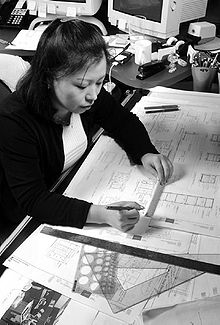- Drafter
-
- See also draughtsman.
Drafters prepare technical drawings and plans, which are used to build everything from manufactured products such as toys, toasters, industrial machinery, and spacecraft to structures such as houses, office buildings, and oil and gas pipelines.[1]
Contents
Overview
In the past, drafters sat at drawing boards and used pencils, pens, compasses, protractors, triangles, and other drafting devices to prepare a drawing by hand. During the late 1980's and early 1990's, drawing boards became largely superseded by the application of Computer Aided Design and Drafting (CADD) systems for the creation of technical drawings. Consequently, some drafters may be referred to as CADD operators.[1]
With CADD systems, drafters can create and store drawings electronically so that they can be viewed, printed, or programmed directly into automated manufacturing systems. CADD systems also permit drafters to quickly prepare variations of a design. Although drafters use CADD extensively, it is only a tool. Drafters still need knowledge of traditional drafting techniques, in addition to CADD skills. Despite the nearly universal use of CADD systems, manual drafting and sketching are used in certain applications.[1]
Drafters’ drawings provide visual guidelines and show how to construct a product or structure. Drawings include technical details and specify dimensions, materials, and procedures. Drafters fill in technical details using drawings, rough sketches, specifications, and calculations made by engineers, surveyors, architects, or scientists. For example, drafters use their knowledge of standardized building techniques to draw in the details of a structure. Some use their understanding of engineering and manufacturing theory and standards to draw the parts of a machine; they determine design elements, such as the numbers and kinds of fasteners needed to assemble the machine. Drafters use technical handbooks, tables, calculators, and computers to complete their work.[1]
Specialties
Drafting work has many specialties:[1]
- Aeronautical drafters prepare engineering drawings detailing plans and specifications used in the manufacture of aircraft, missiles, and related parts.
- Architectural drafters draw architectural and structural features of buildings and other structures. These workers may specialize in a type of structure, such as residential or commercial, or in a kind of material used, such as reinforced concrete, masonry, steel, or timber.
- Civil drafters prepare drawings and topographical and relief maps used in major construction or civil engineering projects, such as highways, bridges, pipelines, flood control projects, and water and sewage systems.
- Electrical drafters prepare wiring and layout diagrams used by workers who erect, install, and repair electrical equipment and wiring in communication centers, power plants, electrical distribution systems, and buildings.
- Electronics drafters draw wiring diagrams, circuit board assembly diagrams, schematics, and layout drawings used in the manufacture, installation, and repair of electronic devices and components.
- Mechanical drafters prepare drawings showing the detail and assembly of a wide variety of machinery and mechanical devices, indicating dimensions, fastening methods, and other requirements.
- Process piping or pipeline drafters prepare drawings used in the layout, construction, and operation of oil and gas fields, refineries, chemical plants, and process piping systems.
- Photovoltaic Drafters prepare drawings showing inverter Pad location drawings and slab construction drawings, also prepare specific PV system assembly details and some wiring diagrams.
- More skilled drafters device and prepare drafting process and methods that expedite the current work flow.
Work environment
Drafters usually work in comfortable offices. They may sit at adjustable drawing boards or drafting tables when doing manual drawings, although most drafters work at computer terminals much of the time. Because they spend long periods in front of computers doing detailed work, drafters may be susceptible to eyestrain, back discomfort, and hand and wrist problems. Most drafters work a standard 40-hour week; only a small number work part time.[1]
Education and training
High school courses in mathematics, science, computer technology, design, computer graphics, and, where available, drafting are useful for people considering a drafting career. Employers prefer applicants who have also completed training after high school at a technical institute, community college, or 4-year college or university.[1]
The kind and quality of drafting training programs vary considerably so prospective students should be careful in selecting a program. They should contact prospective employers to ask which schools they prefer and contact schools to ask for information about the kinds of jobs their graduates have, the type and condition of instructional facilities and equipment, and teacher qualifications.[1]
Technical institutes offer intensive technical training, but they provide a less general education than do community colleges. Either certificates or diplomas may be awarded. Many technical institutes offer 2-year associate degree programs, which are similar to, or part of, the programs offered by community colleges or State university systems. Their programs vary considerably in length and in the type of courses offered. Some public vocational-technical schools serve local students and emphasize the type of training preferred by local employers. Most require a high school diploma or its equivalent for admission. Other technical institutes are run by private, often for-profit, organizations sometimes called proprietary schools.[1]
See also
References
Categories:
Wikimedia Foundation. 2010.

